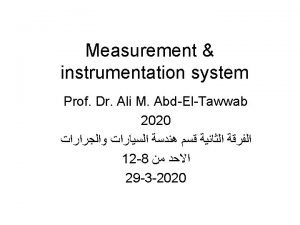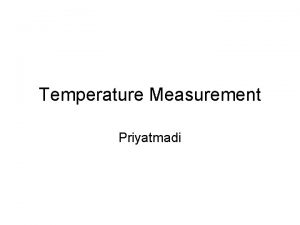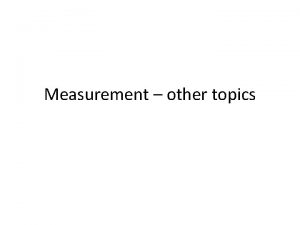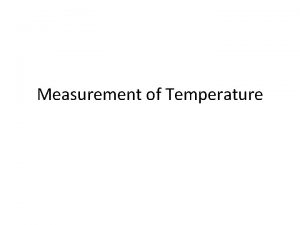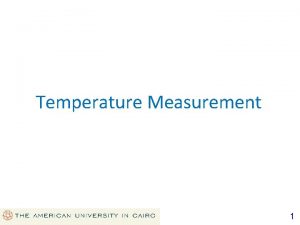Temperature measurement Principles of temperature measurement the triple


























- Slides: 26


Temperature measurement


Principles of temperature measurement • the triple point of equilibrium hydrogen 259. 34°C • the boiling point of oxygen 182. 962°C • the boiling point of water 100. 0°C • the freezing point of zinc 419. 58°C • the freezing point of silver 961. 93°C • the freezing point of gold 1064. 43°C (all at standard atmospheric pressure)


Instruments to measure temperature can be divided into separate classes according to the physical principle on which they operate. The main principles used are: The thermoelectric effect Resistance change Sensitivity of semiconductor device Radiative heat emission Thermography Thermal expansion Resonant frequency change Sensitivity of fibre optic devices Acoustic thermometry Colour change Change of state of material.


Thermoelectric effect sensors (thermocouples) Thermoelectric effect sensors rely on the physical principle that, when any two different metals are connected together, an e. m. f. , which is a function of the temperature, is generated at the junction between the metals

Thermocouple









Varying resistance devices • Varying resistance devices rely on the physical principle of the variation of resistance with temperature. The devices are known as either resistance thermometers or thermistors according to whether the material used for their construction is a metal or a semiconductor, and both are common measuring devices

Resistance thermometers, which are alternatively known as resistance temperature devices (or RTDs), rely on the principle that the resistance of a metal varies with temperature according to the relationship:

Resistance thermometer, RTD



Thermistors are manufactured from beads of semiconductor material prepared from oxides of the iron group of metals such as chromium, cobalt, iron, manganese and nickel. Normally, thermistors have a negative temperature coefficient, i. e. the resistance decreases as the temperature increases, according to:



Semiconductor devices, consisting of either diodes or integrated circuit transistors, have only been commonly used in industrial applications for a few years, but they were first invented several decades ago. They have the advantage of being relatively inexpensive, but one difficulty that affects their use is the need to provide an external power supply to the sensor
 Triple alliance
Triple alliance Triple alianza y triple entente
Triple alianza y triple entente Triple alliance ww1
Triple alliance ww1 Triple entente
Triple entente Sistema de alianzas primera guerra mundial
Sistema de alianzas primera guerra mundial Triple jump measurements
Triple jump measurements Triple jump measurement
Triple jump measurement Difference between curie temperature and neel temperature
Difference between curie temperature and neel temperature Difference between curie temperature and neel temperature
Difference between curie temperature and neel temperature Difference between antiferromagnetism and ferrimagnetism
Difference between antiferromagnetism and ferrimagnetism Principle of measurement of temperature
Principle of measurement of temperature Anthropometric measurement includes vital signs
Anthropometric measurement includes vital signs 3 point circle
3 point circle Hát kết hợp bộ gõ cơ thể
Hát kết hợp bộ gõ cơ thể Bổ thể
Bổ thể Tỉ lệ cơ thể trẻ em
Tỉ lệ cơ thể trẻ em Voi kéo gỗ như thế nào
Voi kéo gỗ như thế nào Chụp phim tư thế worms-breton
Chụp phim tư thế worms-breton Hát lên người ơi
Hát lên người ơi Các môn thể thao bắt đầu bằng tiếng bóng
Các môn thể thao bắt đầu bằng tiếng bóng Thế nào là hệ số cao nhất
Thế nào là hệ số cao nhất Các châu lục và đại dương trên thế giới
Các châu lục và đại dương trên thế giới Công thức tính thế năng
Công thức tính thế năng Trời xanh đây là của chúng ta thể thơ
Trời xanh đây là của chúng ta thể thơ Mật thư anh em như thể tay chân
Mật thư anh em như thể tay chân Phép trừ bù
Phép trừ bù










